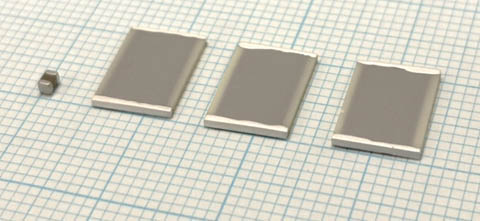Cooling accounts for ever more of the worldwide energy budget, and novel approaches are under continuous investigation. For example, there has been significant focus on highly engineered prototype cooling devices with large temperature spans, which exploit magnetically driven temperature changes of just 2.5 K near the room-temperature ferromagnetic phase transition in gadolinium.
For materials that are cooled in an analogous manner using a voltage, the temperature changes have been even smaller in embodiments that are large enough for applications. It is therefore with great excitement that we report electrically driven changes of 5.5 K in large multilayer capacitors of the ceramic Pb0.5Sc0.5TaO3 (PST) near room temperature. Moreover, the temperature change remains large over a much wider range of starting temperatures than gadolinium.
The key step was to drive the (first order) ferroelectric phase transition in PST using supercritical electric fields without breakdown.
The design principles established for magnetic cooling can now be repurposed for better cooling with multilayer capacitors of PST. Moreover, bulky and expensive magnets would not be required to drive the phase transition. It therefore appears that gadolinium has been outcompeted in the evolutionary struggle to improve the way we cool things.
Figure caption: the dark active area in the three multilayer capacitors of PST can be cooled by 5.5 K on removing an applied voltage near room temperature. For comparison, we show a commercially available capacitor of doped barium titanate in which the corresponding temperature change is just 0.5 K.
B. Nair, T. Usui, S. Crossley, S. Kurdi, G. G. Guzmán-Verri, X. Moya, S. Hirose and N. D. Mathur, “Large electrocaloric effects in oxide multilayer capacitors over a wide temperature range”, Nature 575, 468 (2019)

